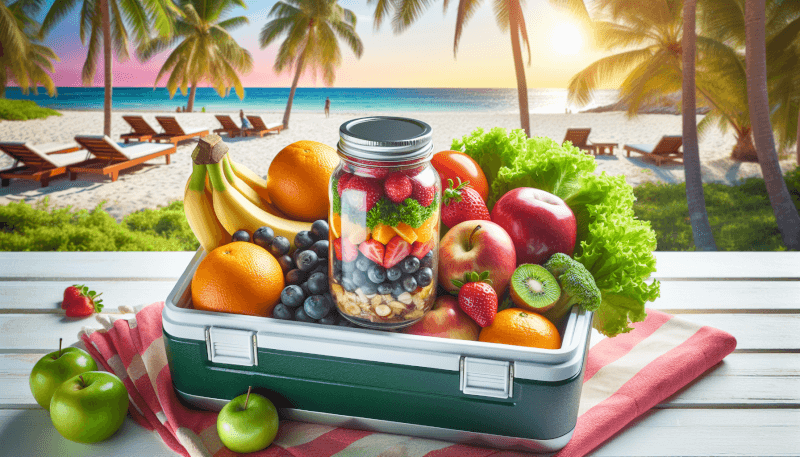Going on vacation is always an exciting time, but one thing that often gets overlooked is what to do with all the food in your fridge. We’ve all experienced the unpleasant surprise of returning home to find spoiled and wasted food. That’s why we’ve put together a list of helpful tips for emptying your fridge before you leave, ensuring that you not only have a clean slate to start fresh when you return, but also that you minimize any unnecessary food waste. So, whether you’re headed to a tropical paradise or exploring a bustling city, these vacation food storage tips will help you make the most of your trip without worrying about what’s in your fridge.
Preparing for Your Vacation
Use up perishable items
Before heading off on your well-deserved vacation, it’s important to take a look at the contents of your fridge and identify any perishable items that need to be used up. By doing so, you can prevent these items from going bad while you’re away. Be creative and try to incorporate these ingredients into your meals for the next few days. Perhaps you can whip up a delicious stir-fry with those bell peppers or make a refreshing fruit salad with those ripe berries. Using up perishable items not only helps reduce food waste but also saves you money.
Freeze leftovers
In case you have any leftovers that won’t be consumed before you leave, freezing them is a great solution. By doing so, you can extend their shelf life and enjoy them when you return from your vacation. Consider transferring the leftovers to freezer-safe containers or wrapping them tightly with plastic wrap and aluminum foil to prevent freezer burn. Don’t forget to label each container with the date and content to ensure you can easily identify them later. Freezing leftovers allows you to minimize waste and gives you a head start on meal prep for your post-vacation meals.
Donate unused food
If you have any unopened food items that you know won’t be consumed before you leave, consider donating them to a local food bank or shelter. It’s a wonderful way to help those in need and make sure the food doesn’t go to waste. Non-perishable items such as canned goods, pasta, and rice can be particularly useful for those who are facing food insecurity. Donating unused food not only benefits others but also gives you a sense of fulfillment knowing that you’ve contributed to your community in a meaningful way.
Cleaning Out the Fridge
Remove all items
Now that you’ve prepared for your vacation by using up perishable items and freezing leftovers, it’s time to clean out your fridge. Start by removing all items from the shelves, drawers, and door compartments. This will allow you to thoroughly clean each part and ensure that no spoiled or expired food items are left behind. Don’t forget to unplug the fridge and allow it to reach room temperature before cleaning.
Check for expiration dates
Once you’ve emptied your fridge, take a few moments to go through each item and check for expiration dates. This step is crucial to ensure that you only consume food that is safe and fresh. Discard any items that have already expired or show signs of spoilage. By removing these items, you’ll prevent any potential health risks and maintain a clean, healthy fridge.
Dispose of spoiled food
If you come across any spoiled or rotten food during the cleaning process, it’s important to dispose of them properly. Put them in sealed bags and throw them into your outdoor trash bin to avoid any unpleasant odors or pests in your home. Remember, keeping your fridge free from spoiled food not only eliminates the risk of foodborne illnesses but also helps maintain a pleasant and fresh environment for your upcoming meals.

Meal Planning Ideas
Create a meal plan
Now that your fridge is sparkling clean and free from expired and spoiled food, it’s time to plan your meals for the upcoming days. Creating a meal plan enables you to maximize the use of ingredients you already have on hand and avoid unnecessary trips to the grocery store. Take a look at your pantry staples and frozen items and get creative with your recipes. By planning your meals in advance, you’ll save time, reduce food waste, and ensure that you have nutritious and delicious meals waiting for you after your vacation.
Use pantry staples
When planning your meals, make sure to incorporate pantry staples that have a long shelf life. Items like canned beans, grains, pasta, and sauces can easily form the base of a variety of meals. Combine these staples with fresh ingredients you may have left to create flavorful and wholesome dishes. Don’t be afraid to experiment with different spices and seasonings to add an extra kick to your meals. Using pantry staples not only helps you make the most of your ingredients but also saves you money by avoiding unnecessary grocery shopping.
Make refrigerator-friendly recipes
While planning your meals, consider choosing recipes that are refrigerator-friendly. These recipes either require minimal cooking time or can be prepared in advance and stored in the fridge until you’re ready to eat. Salads, wraps, sandwiches, and overnight oats are great options that utilize fresh ingredients while still being convenient and easy to prepare. By choosing refrigerator-friendly recipes, you’ll have delicious meals that are ready to enjoy whenever you need a quick and convenient option.
Proper Food Storage Techniques
Utilize airtight containers
To maintain the freshness and extend the shelf life of your food, it’s crucial to utilize airtight containers. These containers help prevent air and moisture from reaching the food, keeping it fresh for a longer period. Invest in quality, BPA-free containers that come with tight-sealing lids. Glass containers are an excellent choice as they are non-toxic, reusable, and can easily go from the fridge to the microwave or oven if needed. By storing your food in airtight containers, you’ll ensure that it remains at its best quality and reduces the risk of cross-contamination in your fridge.
Label and date items
To avoid confusion and ensure that you use your stored food items in a timely manner, it’s essential to label and date each container. Use a marker or sticky labels to indicate the contents of the container and the date it was stored. This practice helps you identify the food easily and reminds you of its freshness. When properly labeled, you can prioritize using items that are closer to their expiration date and reduce the chances of forgetting about hidden treasures in the back of your fridge.
Store food in an organized manner
Keeping your fridge organized is not just visually pleasing but also functional. Arrange your food items in a way that makes it easy for you to find what you need. Consider grouping similar items together, such as dairy products, fruits, vegetables, and condiments. This organization helps prevent food from getting lost or forgotten in the depths of your fridge. Additionally, by keeping your fridge organized, you’ll be able to see at a glance what needs to be consumed before it goes bad, making meal planning and grocery shopping much more efficient.

Prolonging Produce Shelf Life
Wrap vegetables in paper towels
When it comes to preserving the freshness of your vegetables, wrapping them in paper towels can make a significant difference. The paper towels absorb excess moisture, preventing the vegetables from becoming limp or moldy too quickly. After washing your vegetables, gently pat them dry with paper towels and then wrap them loosely in another piece of paper towel before placing them in a plastic bag or airtight container. This simple technique extends the shelf life of your vegetables, allowing you to enjoy crisp and nutritious produce even after your vacation.
Store leafy greens in airtight bags
Leafy greens, such as lettuce, spinach, and kale, tend to wilt quickly if not stored properly. To keep them fresh and crisp, place the unwashed greens in airtight bags before storing them in the crisper drawer of your fridge. The airtight bags help maintain the moisture levels and prevent wilting. Just remember to remove any excess air from the bag before sealing it. By taking this extra step, you’ll be greeted with vibrant and nutritious greens when you return from your vacation.
Separate ethylene-producing fruits
Did you know that certain fruits produce a natural gas called ethylene, which can accelerate the ripening process of other fruits? To prevent your produce from ripening too quickly and potentially going bad while you’re away, it’s important to separate ethylene-producing fruits from other fruits and vegetables. Some common ethylene-producing fruits include apples, bananas, and avocados. Store these fruits separately, either in a fruit bowl on your kitchen counter or in a separate compartment in your fridge. This simple practice will help you maintain the quality and freshness of your produce for a longer period.
Using Up Frozen Foods
Check freezer inventory
Before you leave for your vacation, take a moment to assess the contents of your freezer. Knowing what you have on hand will not only help you plan your meals but also prevent food waste in the long run. Make a list of the frozen items you have and evaluate if any of them can be incorporated into your meal plans. By doing so, you’ll avoid buying unnecessary groceries and utilize what you already have, saving money and reducing waste.
Plan meals around frozen items
Once you’re aware of the frozen items you have, it’s time to incorporate them into your meal planning. Look for recipes that allow you to use these frozen ingredients as the main components. Whether it’s a hearty vegetable stew, a flavorful pasta dish, or a scrumptious casserole, frozen ingredients can serve as the foundation of delicious and convenient meals. Don’t forget to thaw the frozen items properly before cooking to ensure even cooking and optimal taste.
Thaw food properly
Properly thawing your frozen food is essential to maintain its quality and safety. The safest method is to thaw food in the refrigerator overnight. This slow and controlled thawing process prevents the growth of harmful bacteria and preserves the texture and taste of the food. If you’re in a hurry, you can also use the microwave’s defrost setting or place the frozen food in a tightly sealed plastic bag and submerge it in cold water. Avoid thawing food at room temperature as it increases the risk of bacterial growth. By following proper thawing techniques, you’ll be able to enjoy your frozen items without compromising their quality.

Creative Leftover Ideas
Combine leftovers for new meals
Leftovers don’t need to be boring or repetitive. Get creative in the kitchen by combining different leftovers to create new and exciting meals. For example, leftover roasted chicken can be shredded and used in a flavorful salad or stuffed into quesadillas. Pasta and cooked vegetables can be transformed into a delicious frittata or added to a soup for extra texture. By thinking outside the box and combining leftovers, you’ll not only keep your meals interesting but also reduce food waste.
Repurpose ingredients
If you have excess ingredients or partial portions of certain foods, consider repurposing them into new dishes. For instance, if you have leftover rice, you can transform it into a tasty fried rice by adding different vegetables, proteins, and sauces. Overripe bananas can be mashed and used in pancakes, muffins, or smoothies. Be creative and let your taste buds guide you. Repurposing ingredients helps prevent food waste while allowing you to enjoy a diverse range of flavors.
Make soups or stews
Soups and stews are excellent options for using up a variety of ingredients, including leftovers. Grab any vegetables, proteins, and grains you have on hand, and simmer them together in a flavorful broth to create a hearty and nutritious soup. Leftover meats, such as chicken or beef, can be diced and added to a stew with potatoes, carrots, and other vegetables. The beauty of soups and stews is that you can adjust the ingredients based on what you have available, making them a versatile and waste-free option for using up leftovers.
Utilizing Canned Goods
Check expiration dates
Before incorporating canned goods into your meals, it’s important to check their expiration dates. While canned goods generally have a long shelf life, it’s still crucial to ensure that they are within the recommended time frame for consumption. Discard any cans that have passed their expiration date or show signs of damage, such as dents or bulges. By checking expiration dates, you’ll guarantee that you’re using safe and high-quality products.
Incorporate canned goods into meals
Canned goods are a convenient and versatile option for meal planning. They can be quickly incorporated into a variety of dishes, from soups and stews to pasta sauces and stir-fries. Canned beans, for example, are not only a great plant-based protein source but can also be added to salads, tacos, or mashed for a dip. Canned tomatoes can serve as the base for a flavorful pasta sauce or a hearty chili. By utilizing canned goods, you’ll save time in the kitchen while still enjoying nutritious and delicious meals.
Donate excess canned food
If you find yourself with an excess of canned goods, consider donating them to those in need. Local food banks and shelters are always grateful for non-perishable donations, as they help feed individuals and families who are experiencing food insecurity. Check the expiration dates on your canned goods and set aside any that are still within their recommended time frame for consumption. Donating excess canned food not only helps reduce waste but also makes a positive impact on your community.

Cleaning and Organizing the Fridge
Remove and clean shelves and drawers
To maintain a clean and hygienic fridge, it’s important to regularly remove and clean the shelves and drawers. Start by taking out all the removable parts and washing them with warm soapy water. Use a sponge or cloth to wipe down the interior of the fridge, paying attention to any spills or sticky spots. Once everything is clean and dry, carefully place the shelves and drawers back in their respective positions. Regular cleaning helps prevent the buildup of food residue and ensures a fresh and odor-free fridge.
Organize items by category
After cleaning, it’s time to organize your fridge in a way that makes it easy to find and access your food. Categorize your items by groups, such as dairy products, fruits, vegetables, condiments, and leftovers. Store similar items together to facilitate meal planning and reduce the chances of forgetting about items hidden in the depths of your fridge. Consider using clear containers or bins to further separate and organize different categories. By maintaining an organized fridge, you’ll save time and have a clearer view of what needs to be consumed before it goes bad.
Maintain a clean fridge
Once your fridge is clean and organized, it’s important to maintain its cleanliness on an ongoing basis. Regularly check for spills or expired food items and promptly clean them to prevent odors and bacterial growth. Wipe down any sticky containers or jars to keep the surfaces clean and avoid cross-contamination. By incorporating these habits into your routine, you’ll ensure that your fridge remains a hygienic and inviting space for your food storage needs.
Final Thoughts
Emptying the fridge reduces waste
When preparing for your vacation, taking the time to empty your fridge of perishable items and plan your meals around what you already have is a great way to reduce food waste. By using up ingredients, freezing leftovers, and donating unused food, you’re not only saving money but also minimizing the environmental impact of wasted food. Embracing the practice of emptying the fridge before your vacation sets a positive precedent for mindful consumption and encourages sustainable habits.
Vacation food storage tips save money
Following proper food storage techniques and utilizing pantry staples, frozen foods, and canned goods allow you to save money while still enjoying delicious meals. By planning your meals, labeling items, and organizing your fridge, you’re able to make the most of what you already have, reducing the need for unnecessary grocery shopping. These vacation food storage tips help stretch your budget and ensure that you’re utilizing all your resources efficiently.
Proper organization makes post-vacation life easier
By cleaning and organizing your fridge before your vacation, you’ll return home to a clean and well-maintained space. With a clear view of what needs to be consumed first and organized categories, you can quickly get back into the swing of meal planning and cooking. Maintaining a clean and organized fridge not only saves time but also helps reduce stress and allows you to focus on enjoying your post-vacation days.
In conclusion, preparing for your vacation involves more than just packing your bags and arranging travel plans. Taking the time to empty your fridge, clean and organize its contents, and plan your meals based on what you already have contributes to a mindful and sustainable approach to food consumption. By using up perishable items, freezing leftovers, donating excess food, and incorporating proper food storage techniques, you’re able to reduce waste, save money, and ensure a stress-free post-vacation experience. So, before embarking on your next vacation, remember to follow these vacation food storage tips for an organized and waste-free fridge. Happy travels!



